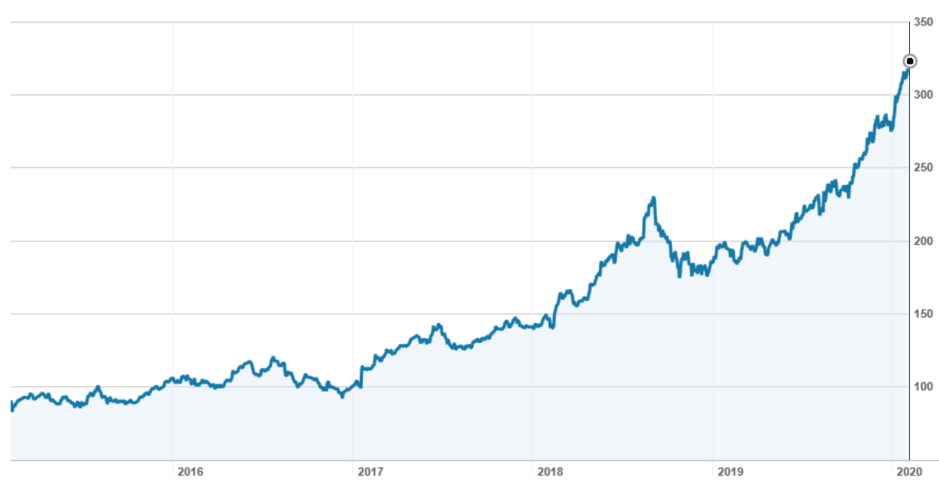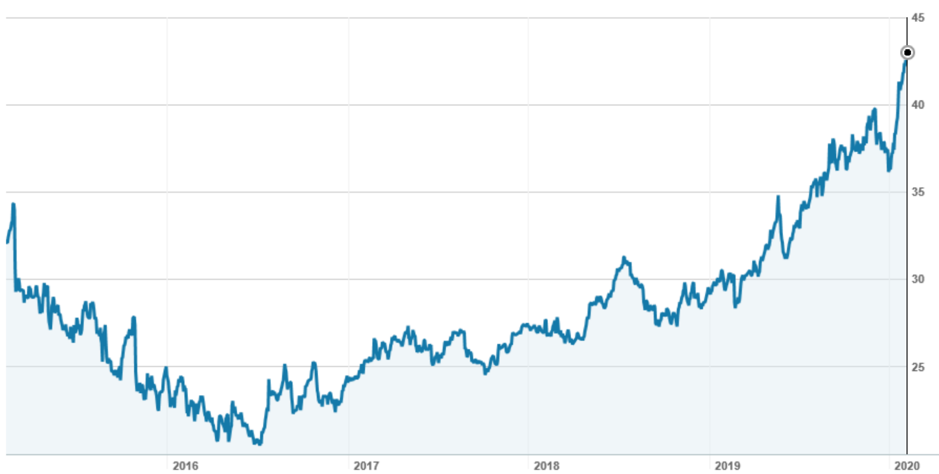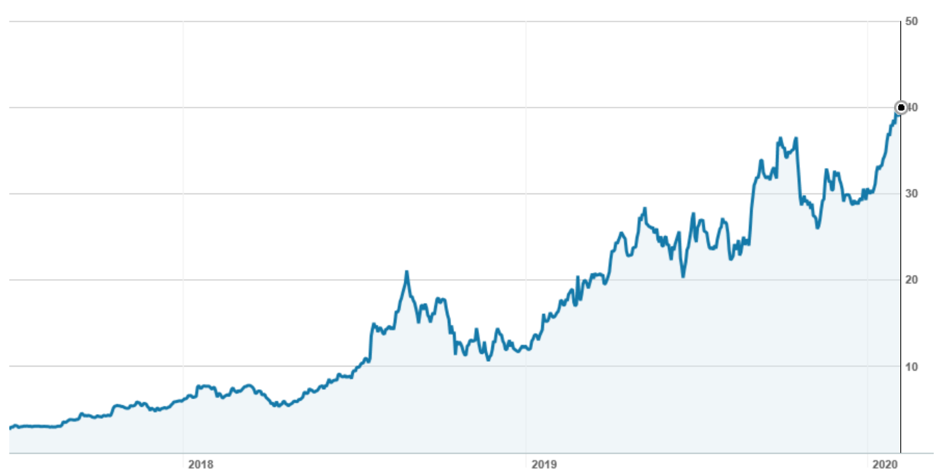In today’s Report, James Dunn analyses the companies reporting earnings over the next seven days [1] – who to look out for, what the market is expecting, and the non-financial measures the market will use to judge the quality.
In this article, I want to focus on the four companies that I think could make or break reporting season. Two report this week, while the other two don’t report until the last week of February. Each is important enough in its own right (albeit for different reasons), as well as being a barometer for market sentiment, such that a credible report will be a fillip to the whole market and help drive it higher. Conversely, a poor result could dent market confidence. Here are the four to watch – and why they are so important.
1. CSL (CSL) – reports Wednesday 12 February
CSL, the global leader in blood plasma products and number two globally in influenza vaccines, is now Australia’s second biggest company by market capitalization – accounting for a massive 7.6% of the entire ASX. On current trends, it will shortly overtake the Commonwealth Bank to be Australia’s biggest company.
It has had a phenomenal run. Up 16% already in 2020, this followed a rise of 49% in calendar 2019 to be Australia’s best performing large cap stock. And if you were lucky enough to purchase shares in the original IPO of the Commonwealth Serum Laboratories in 1994 at an effective price of $0.77 per share, you have seen a gain of over 42,000%.
CSL – 2/2015 to 2/2020

For years, many of Australia’s major fund managers shunned CSL. They argued that it was too expensive (it trades on a multiple of around 45 times forecast FY20 earnings), was expensive on a relative basis compared to global health care peers, and that its growth trajectory was unsustainable. Retail investors also shunned the stock because it doesn’t pay a franked dividend and the yield barely gets above 1% pa.
But these investors have been caught out, and because CSL has become so big, they can’t afford to be “under-weight” any longer. In the institutional funds’ management business, consistent underperformance relative to the benchmark index is death. An underweight position in CSL is a huge risk, even for defensive, income oriented funds, and many managers have been forced into buying CSL to minimise the tracking risk. Long “value” stocks and short “growth” stocks, they are fighting the momentum in the market which is with “growth”. Together with a shortage of stocks in Australia with top and bottom line growth, these factors are driving the rush to buy CSL and its phenomenal price performance.
In fact, CSL’s guidance for profit and sales growth in FY20 (by historical CSL standards) is relatively modest. It has guided to full year revenue growth in FY20 (on a constant currency basis and after adjusting for a change to its distribution model in China) of 10%. For profit, it has guided to a full year profit in the range of US$2,050m to US$2,110m – an increase of 7% to 10%.
CSL has a history of “over-delivering” and surprising on the upside when it delivers its profit results. The market will be hoping that CSL can do it again when it reports on Wednesday. First half profit, which is seasonally higher than the second half, is forecast to come in around US$1,270m. While this is important, the market will be more interested in its profit guidance for the full year, and the trajectory of sales growth. If CSL raises guidance or says that it should come in at the top end, this will be an important confirmation for those investors who have made the switch back to growth companies such as CSL, and will be a fillip to the whole market. If CSL disappoints, the market could be tested.
2. Commonwealth Bank (CBA) – reports Wednesday 12 February
Commonwealth Bank also reports this Wednesday. As Australia’s largest company by market capitalization, and the leader in the market’s biggest sector, financials, it is always important when it reports. But with the major banks still largely out of favour with the market, any suggestion that things could be on the up with the CBA would be a fillip for the market.
It is also trading at close to a record premium compared to its major bank rivals. On forecast earnings for FY21, CBA is priced at a premium of 35% to Westpac and NAB, and around 38% to the ANZ. Expectations are high!
The Bank provided an update for its first quarter and reported a cash profit of $2.26bn. This quarter will be impacted by a provision for bushfire claims, but should come in at around about the same level giving a half year total of $4.5bn. This will be an improvement on the June half year adjusted outcome of $3,816m, but down on the corresponding half in FY19 of $4,676m.
Key areas that the market will focus on are:
- The maintenance (or not) of the dividend at 200c per share – and what this says about Management’s confidence in future earnings;
- The trajectory of the net interest margin;
- Volume growth, particularly in relation to home loans. In the first quarter, CBA grew its home loan book by 3.5% and business banking loans by 2.8% compared to the final quarter of FY19;
- Operating expense growth – is this flat, or very, very low digit?
- The possibility of an off-market share buyback, with some analysts suggesting that CBA could announce a buyback in the range of $1.5bn to $2bn.
Commonwealth Bank – 2/15 to 2/2020

3. Woolworths (WOW)- reports Wednesday February 26
Over the last 12 months or so, Woolworths has also enjoyed a phenomenal run as the so called “expensive defensives” have become even more expensive. These are stocks with very predictable earnings, low volatility and typically low growth. Examples include consumer staples such as Woolworths and Coles, Transurban, Sydney Airport and the property trusts. Woolworths is currently trading on a multiple of 29.3 times forecast FY20 earnings and 27.1 times forecast FY21 earnings.
Woolworths – 2/15 to 2/2020

Competitor Coles provided an update last week, detailing a better overall earnings performance for the half year and an improvement in sales for the second quarter. Food sales on a comparable store basis increased in the second quarter by 3.6%, following an increase of 0.9% in the first quarter. Woolworths, which had an outstanding first quarter growth rate of 6.6% for food in part due to the success of its Lion King Ooshies promotion, should maintain its leadership over Coles and also deliver a strong second quarter.
Woolworths will provide an update on the separation of its Endeavour Drinks business (hotels, Dan Murphy’s, BWS), and the remediation of a staff underpayment issue. The market will also be watching for progress in relation to the troubled BigW division – sales growth and movement back towards profitability. A small lift in dividend is expected – from 45c to 47c per share.
As the largest of the “expensive defensives”, a strong result by Woolworths will help to sustain the momentum these stocks have enjoyed.
4. Afterpay (APT) – reports Thursday 27 February
Afterpay is one of the leaders in the information technology sector – the second best performing sector on the ASX after healthcare – and a sector that typifies the growth thematic. Xero is probably a better regarded stock, but it is not reporting during this earnings season and so the market will take its cues from Afterpay.
Forget about earnings (although Afterpay is expected to become profitable in FY20), this is just about the growth drivers and in particular, growth in the USA. In the last 12 months, Afterpay’s share price has more than doubled largely on the back of a view that Afterpay can become hugely important and a leader in the ‘buy now, pay later’ category in the USA.
Afterpay – 6/17 to 2/2020

The company has already provided an update for the first four months of the half year to 31 October. The market will be focussed on whether the growth has been sustained in the final two months, and management’s outlook for the next six months.
To recap, these were the highlights from the October trading update:
- Number of active merchants – to 31/10/19, up 96% on previous corresponding period in 2018 and up 22% on prior 4 months;
- Active customers – up 137% on previous corresponding period and 32% on prior 4 months; and
- Sales – $2.7bn to 31/10/19, which was up 110% on previous corresponding period and 22% on the prior 4 months.
Frequency trends (how many times customers are purchasing using Afterpay), as well as the net transaction margin (an expectation that this hasn’t deteriorated) will be other key watchpoints.
The composition of growth will also be important, with accelerating growth in the USA and the UK offsetting decelerating growth in Australia.
And while it is tempting to dismiss Afterpay and some of the other darlings in the information technology sector, they represent that other really strong market thematic – growth stocks are becoming even more expensive. That’s why Afterpay, as a market leader in this sector, is important in relation to how earning season is viewed. Its report will help shape market sentiment, with a strong report boosting confidence and potentially giving the market a lift higher.
Important: This content has been prepared without taking account of the objectives, financial situation or needs of any particular individual. It does not constitute formal advice. Consider the appropriateness of the information in regard to your circumstances.